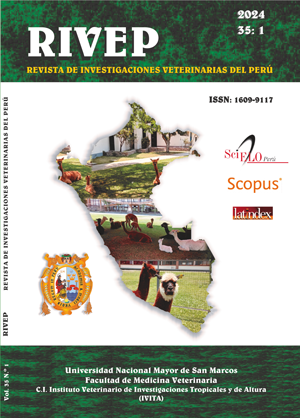Textile characteristics and fibre length at dehairing on vicuña fleece
DOI:
https://doi.org/10.15381/rivep.v35i1.27377Keywords:
manual dehairing, fibre dehaired, guard hair, medullation, spinning finenessAbstract
The aim of this research was to determine the variation of textile characteristics and fibre length when manually dehairing vicuña fleece, as well as to evaluate the influence of sex, age, fleece sampling site, and place of origin of the vicuña on fibre quality characteristics. Manual dehairing was carried out on 77 samples of vicuñas from three provinces of the department of Apurímac, Peru. The textile characteristics of the fibre before and after dehairing were determined using OFDA 2000 device and evaluated by analysis of variance, t test and Tukey (α=0.05). The quality of dehaired fibres is superior to the non-dehaired fibre, due to the reduction of mean fibre diameter (MFD) (-1.68 μm), standard deviation of FMD (SD) (-0.73) and spinning fineness (SF) (-1.27 μm) and the increase in the percentage of fibres <30 µm (CF) (1.12%) and the mean curvature (CU) (6.75 °/mm). In dehaired fibre, juveniles have a finer MFD (12.24 μm) than adults (13.01 μm), the MFD of the middle side is finer (12.39 μm) compared to the shoulder (12.81 μm) and rump (12.77 μm). Likewise, variation in textile characteristics (SD, CV, CF, and CU) and fibre length was found among the fleeces from the three provinces of Apurímac. In conclusion, manual dehairing reduces the mean fibre diameter and its standard deviation and increases the mean curvature and fibre comfort, improving the quality and uniformity properties of the yarn.
Downloads
Downloads
Published
Issue
Section
License
Copyright (c) 2024 Rubén Pinares, Franklin Lozano, Virgilio Machaca

This work is licensed under a Creative Commons Attribution 4.0 International License.
AUTHORS RETAIN THEIR RIGHTS:
a. Authors retain their trade mark rights and patent, and also on any process or procedure described in the article.
b. Authors retain their right to share, copy, distribute, perform and publicly communicate their article (eg, to place their article in an institutional repository or publish it in a book), with an acknowledgment of its initial publication in the Revista de Investigaciones Veterinarias del Perú (RIVEP).
c. Authors retain theirs right to make a subsequent publication of their work, to use the article or any part thereof (eg a compilation of his papers, lecture notes, thesis, or a book), always indicating the source of publication (the originator of the work, journal, volume, number and date).



